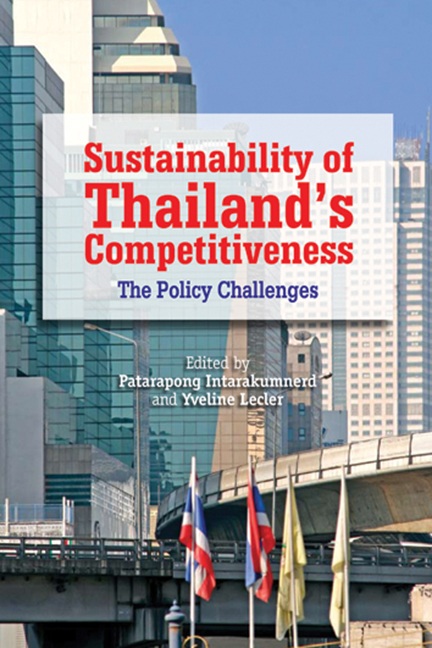Book contents
- Frontmatter
- Contents
- Preface
- Abbreviations
- Contributors
- Introduction
- Part I Thailand's Industrial Development: General Views
- Part II The Roles of Institutions: Clusters and Industrial Estates
- Part III Firms and Government New Initiatives: The Industry Analysis
- 6 Manufacturing and Management Systems of Japanese Manufacturers in Southeast Asia: The Case of Automobile Industry in Thailand
- 7 The Textile and Garment Industry in Thailand: The Technology and Education Upgrading Challenge
- 8 From Growth Based on Low Cost to Capability Upgrading Policies: The Thai Hard Disk Drive Industry
- Index
7 - The Textile and Garment Industry in Thailand: The Technology and Education Upgrading Challenge
from Part III - Firms and Government New Initiatives: The Industry Analysis
Published online by Cambridge University Press: 21 October 2015
- Frontmatter
- Contents
- Preface
- Abbreviations
- Contributors
- Introduction
- Part I Thailand's Industrial Development: General Views
- Part II The Roles of Institutions: Clusters and Industrial Estates
- Part III Firms and Government New Initiatives: The Industry Analysis
- 6 Manufacturing and Management Systems of Japanese Manufacturers in Southeast Asia: The Case of Automobile Industry in Thailand
- 7 The Textile and Garment Industry in Thailand: The Technology and Education Upgrading Challenge
- 8 From Growth Based on Low Cost to Capability Upgrading Policies: The Thai Hard Disk Drive Industry
- Index
Summary
At the beginning of the twentieth century, and despite in-depth reforms implemented by King Chulalongkorn, Siam, as the country was named at the time, was still very traditional in its political, social and economic structures. Economic life in the country was dominated by Royal patronage and an elite linked to the Royal Family. This started to change with the surge in Chinese migration, urbanization, and internationalization of the kingdom. The society, as a consequence, evolved more complex and diverse; governing and trading patterns reshuffled with the rise of a market economy and the involvement of various foreign partners. The absolute monarchy, unable to adapt, fell in 1932 and the following decades witnessed an alternation between “strong-state” and “state for the well-being of people” governing patterns, with the “strong state” tradition being dominant (Baker and Phongpaichit 2005).
Different actors have fuelled the mutation and their agency is relevant for pointing out the mechanisms and forces at stake in the various steps undertaken. Indeed, the textile industry, which is a bridge between the past and the future, epitomizes Thailand's transformation well. In that sense it is a relevant example for emphasizing not only where Thailand comes from, but also what the current threats and needs are to ensure its sustainability.
Surveying the industry's long history clearly shows a move from production based in the villages and anchored in tradition and self-reliant living, to manufacturing oriented towards exports and relying on plants in which foreign investors have had an important role. The insight into Thai textile industry is, therefore, a way to stress the role played by different actors, namely the government, domestic entrepreneurs, banks, and foreign investors, in the build-up of the Thai market economy (part 1).
But, for the last two decades, the textile industry's weight in the national economy (contribution to GDP, exports, employment) has started to fall. This is to some extent due to the rise of other industries such as electronics or automotive, but this positive explanation is not the whole story.
- Type
- Chapter
- Information
- Sustainability of Thailand's CompetitivenessThe Policy Challenges, pp. 235 - 273Publisher: ISEAS–Yusof Ishak InstitutePrint publication year: 2010

